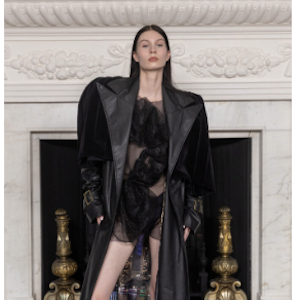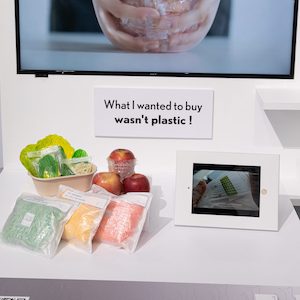Romance: Loving The New with Lexus
By Adrien Communier
Milan Design Week is quite the awesome experience. A week of pop up instalments cover the city, from literally companies that make pots and cushions to car companies and now of course the fashion brands are making their presence felt. The nicest element of the design festival is that all pop ups around the city are open to all to come and view. There is a huge trade fair, but thats for the hardcore, with the city installations being targeted not just at press and buyers but for brands to get their messages out direct to the public, the city is littered with delightful eye candy. Walk around a corner and find yourself in a tiny square which has been taken over by landscape gardeners an turned into a music garden. Walk across the road to a fashion store (this time Stone Island) and find their space been given over to John Alfredo Harris, a British eco-friendly furniture craftsman.
But for us? Well the highlights definitely included the design competition from Lexus. For the past four years, luxury Lexus cars have made a point of supporting up-and-coming designers those who shape a revolutionary future through innovation. Lexus have always believed in the idea of what the future can bring, hence this being the entire purpose of the competition: To help and support the next generation of innovators.
Each year they choose a theme for those contributing to work around, with this year’s theme being Anticipation. With more than 1200 initial submissions, whittled down to twelve, who were invited to present their work at Milan Design Week Lexus space which then ultiamtley highlighted the four finalists.Lexus showed a huge commitment to these four young talents by pairing them up to mentors to guide them through the process, and in order to be able to present larger installations with actual physical prototypes of their ideas.
However, in order to set the scene and to create an unique experience to house the whole competition alongside displaying the work of their candidates, Lexus asked Amsterdam-based design duo Formafantasma and Japanese Michelin-star winner chef Yoji Tokuyoshi to get involved in the physical and emotional presentation for a complete experience from the beginning you entered the installation. The physical ‘pop up’ build drew you into the old garage along a soft light wooden pathway and pulled you thorough the different spaces culminating in being able to taste Tokuyoshi’s dishes created uniquely for the event.


 Walking alongside this wooden bridge in itself created a form of anticipation leading you into the Lexus space, almost like a way of walking towards the future. A little bit further on the walkway, there was a second space where you could take either one of the two portals leading to the chef’s dishes.
Walking alongside this wooden bridge in itself created a form of anticipation leading you into the Lexus space, almost like a way of walking towards the future. A little bit further on the walkway, there was a second space where you could take either one of the two portals leading to the chef’s dishes.
Both the chef and the designers took inspiration straight from Lexus’ concept car LF-FC working with the new hydrogen fuel cell technology. This concept car has water as the only waste element so the idea of water and floating were inter-twinned with they work. Both view Lexus as a very forward-thinking company so Tokuyoshi created two dishes for the audience: Transparency (a bonito fish soup revealing a jelly tasting like mandarin) and Buoyancy (a nasturtium leaf floating on water). Tokuyoshi’s dishes complimented the physical installation by studio Forfafantasma. The duo displayed a series of three installations for Milan Design Week. The first one was a multi-dimensional image of a Lexus concept car created thanks to the shades of thousands of threads with colour sections and as the threads were moving, the image changed. A different room featured metallic circles changing between grey and blue depending on how the light hit them. The last installation was an hydrogen fuel cell technology inspired mechanism making large steel pieces move.


 And what about the contributors? The work that stood out unexpectedly was the work that looked towards making the world a better place. Unsurprisingly, the next generation of designers are driven by equality and caring for the environment in which we all live. We saw several ideas that looked to help or put back into the world rather than idea of yet more things to buy. Several pieces stood out during our visit: Drop Box by Ding Dong, Ma Jincai, Peter Luo and Huang Junxi Drop Box utilises aerodynamics to allow critical supplies to be airdropped safely in a disaster areas without requiring a parachute. Parachutes are of course, very large and expensive to product and difficult to then recycle (that is if you can even get them back). Paper of course, is biodegradable. This very simple yet extremely clever drop box works by putting the heaviest of items (let’s say water) at the bottom of the cone and the lightest items (say clothes) as the top.
And what about the contributors? The work that stood out unexpectedly was the work that looked towards making the world a better place. Unsurprisingly, the next generation of designers are driven by equality and caring for the environment in which we all live. We saw several ideas that looked to help or put back into the world rather than idea of yet more things to buy. Several pieces stood out during our visit: Drop Box by Ding Dong, Ma Jincai, Peter Luo and Huang Junxi Drop Box utilises aerodynamics to allow critical supplies to be airdropped safely in a disaster areas without requiring a parachute. Parachutes are of course, very large and expensive to product and difficult to then recycle (that is if you can even get them back). Paper of course, is biodegradable. This very simple yet extremely clever drop box works by putting the heaviest of items (let’s say water) at the bottom of the cone and the lightest items (say clothes) as the top. PLANTS-SKIN by Hiroto Yoshizoe PLANTS-SKIN is a planter made of a coloured mortar and special ink that visualises the timing for watering plants. When the water runs out the pot becomes dry and goes back to white. Once water is added the pot is coloured so it is very easy to visualise when the plants will need watering.
PLANTS-SKIN by Hiroto Yoshizoe PLANTS-SKIN is a planter made of a coloured mortar and special ink that visualises the timing for watering plants. When the water runs out the pot becomes dry and goes back to white. Once water is added the pot is coloured so it is very easy to visualise when the plants will need watering. Ultimately lets present the four finalists: DADA by Myungsik Jang DADA is a toy block that can be easily combined with bands, holes and pegs to respond to each child’s imagination. Inspired by Japanese traditional toys these blocks help to suggest from a very early age what sort of areas of interest a particular child may go on to be engaged with. Each shape draws different emotions from the child, so watching which cubes they pick will be a great insight into their future. Materials of each block represents characteristics inspired by the philosophy of Yin and Yang. Cube shaped blocks and soft materials represent Yin while Cylinder shaped blocks and hard materials represent Yan. Each of the seven blocks symbolises one of the 7 elements (moon, fire, water, wood, metal, earth, and sun).
Ultimately lets present the four finalists: DADA by Myungsik Jang DADA is a toy block that can be easily combined with bands, holes and pegs to respond to each child’s imagination. Inspired by Japanese traditional toys these blocks help to suggest from a very early age what sort of areas of interest a particular child may go on to be engaged with. Each shape draws different emotions from the child, so watching which cubes they pick will be a great insight into their future. Materials of each block represents characteristics inspired by the philosophy of Yin and Yang. Cube shaped blocks and soft materials represent Yin while Cylinder shaped blocks and hard materials represent Yan. Each of the seven blocks symbolises one of the 7 elements (moon, fire, water, wood, metal, earth, and sun).
 Shape Shifters by Angelene Laura Fenuta Shape Shifters is a special cut of garment, applying modular principles to textile, which allows creating different outfits. This means that once the fabric has been made is can be bent into shape to create a garment, less sewing less waste alongside an ability to meld a garment without having to stitch it, or design outfits that have a flexibility not seen as of yet in fashion.
Shape Shifters by Angelene Laura Fenuta Shape Shifters is a special cut of garment, applying modular principles to textile, which allows creating different outfits. This means that once the fabric has been made is can be bent into shape to create a garment, less sewing less waste alongside an ability to meld a garment without having to stitch it, or design outfits that have a flexibility not seen as of yet in fashion. TRACE by STUDIO AYASKAN Trace is a clock that uses a liquid with UV rays and discolouration properties, allowing us to visualise the passing time. The designers (two sisters) wanted to bring back the ideas of the emotions we go through on a daily basis and to be able to think and almost ‘record’ those emotions. Through “Trace”, they wanted to show that there is a connexion between past, present and future. The clock makes us realiaze that the present not only leaves traces in our past but also sets the path to our future.
TRACE by STUDIO AYASKAN Trace is a clock that uses a liquid with UV rays and discolouration properties, allowing us to visualise the passing time. The designers (two sisters) wanted to bring back the ideas of the emotions we go through on a daily basis and to be able to think and almost ‘record’ those emotions. Through “Trace”, they wanted to show that there is a connexion between past, present and future. The clock makes us realiaze that the present not only leaves traces in our past but also sets the path to our future.
 And the winner of the 2016 Lexus Design Award? Agar Plasticity by AMAM. The collective presented a project exploring how agar, a gelatinous material obtained from marine algae, can be used as an environmentally friendly packaging material alternative to plastic. In a time when everybody worries about the environment and what kind of footprint we will leave, Agar Plasticity is a clever solution to a modern problem. It is not just an idea but something that can really work which makes it very exciting. It is more than a concept, it’s something durable and rather than anticipate, AMAM creates the future.
And the winner of the 2016 Lexus Design Award? Agar Plasticity by AMAM. The collective presented a project exploring how agar, a gelatinous material obtained from marine algae, can be used as an environmentally friendly packaging material alternative to plastic. In a time when everybody worries about the environment and what kind of footprint we will leave, Agar Plasticity is a clever solution to a modern problem. It is not just an idea but something that can really work which makes it very exciting. It is more than a concept, it’s something durable and rather than anticipate, AMAM creates the future.







